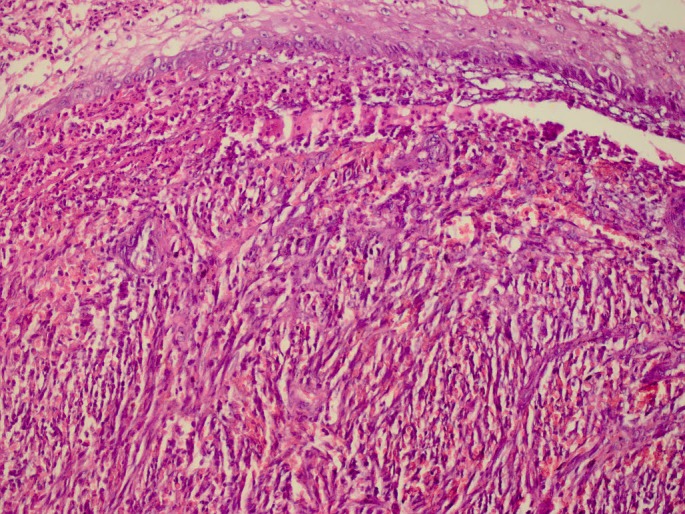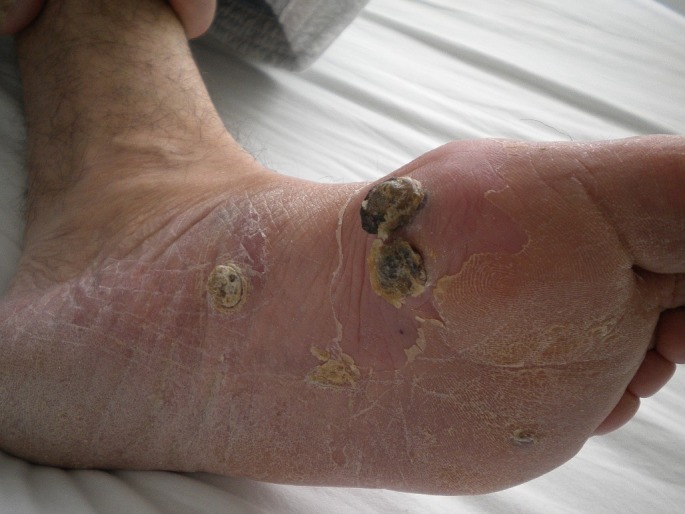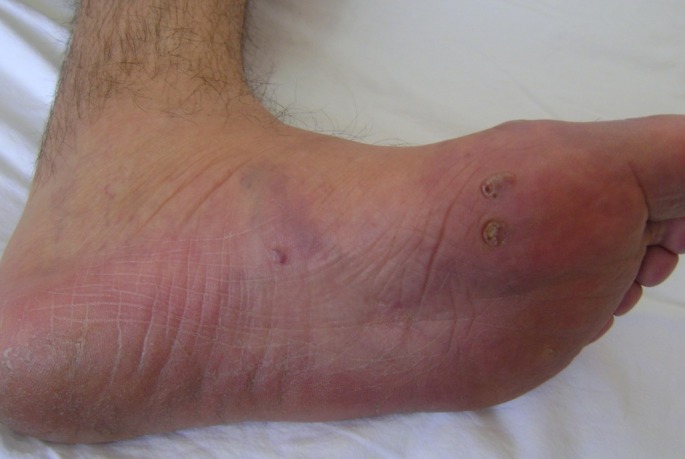Abstract
Background
The classic Kaposi sarcoma is most common in the Mediterranean population over 50 years of age and presents with reddish-brown papules and nodules particularly on the lower limbs. Treatment depends on the clinical presentation and extension of lesions. Imiquimod is as an immune response modifier with antiangiogenic activity.
Main observations
We present a 74-year-old man with classic Kaposi sarcoma who had multiple, small, violaceous papules and nodules on the trunk and extremities with a history of 14 years. He complained particularly from plantar hyperkeratotic painful nodules. Treatment with imiquimod 5% cream under occlusion resulted with almost complete regression within 12 weeks. No local or systemic side effects were observed.
Conclusions
Topical imiquimod was a safe and effective therapy in our patient with classic Kaposi sarcoma.
Keywords: imiquimod, Kaposi sarcoma, skin cancer, treatment
Introduction
Kaposi’s sarcoma (KS) is a vascular neoplasm first described in 1872 by Moritz Kaposi. Four variants have been described: classic, endemic African, immunosuppression-associated, and human immunodeficiency virus (HIV) related.[1,2,3]
The classic variant is most common in the Mediterranean population over 50 years of age. Clinically it presents with reddish-brown papules and nodules particularly on the lower limbs. Less frequently, the lesions may be located on the upper arms, forearms, trunk, eyelids, and genital area. The disease has a slow progression and benign course. Visceral or mucosal involvement is uncommon.[1,2,3]
Case Report
We present a 74-year-old man with multiple, small, violaceous papules and nodules on the trunk and extremities with a history of 14 years. The histopathological examination of the lesions had given the diagnosis of Kaposi sarcoma [Fig. 1]. Dermatological examination revealed approximately 10-15 violaceous papules and nodules with the size of 0.5-1 cm scattered on the trunk and on the upper and lower extremities. Oral mucosa was normal. Serology for hepatitis B and C viruses and HIV were negative. No signs of systemic involvement were found with the computerized tomography of the chest and abdomen.
Figure 1.

Fascicles of atypical spindled cells and slit-like vascular channels (H&Ex100).
The patient was complaining particularly from the plantar hyperkeratotic painful nodules [Fig. 2]. He rejected surgical intervention or radiotherapy. Therefore, occlusive treatment with imiquimod 5% cream was started. In the first week we applied thrice a week, no irritation was seen. Then we continued with everyday application. Rapid remission occurred within a month and almost complete regression was seen in the third month of treatment [Fig. 3]. No local or systemic side effects of imiquimod occurred within the treatment period. No recurrences were seen in the 6-month follow-up period.
Figure 2.

Hyperkeratotic nodules on the sole.
Figure 3.

Almost complete remission with topical 5% imiquimod at the end of 12 weeks.
Discussion
Various treatment modalities are used in classical KS depending on the clinical presentation and extension of lesions. Surgical excision is a good therapeutic option in isolated lesions, and local radiation therapy can be used in the case of multiple lesions. Systemic treatments with vinblastine, bleomycin, doxorubicin, etoposide, or intralesional interferon alpha have been used, besides cryotherapy, laser or photodynamic therapy.[1,2]
Topical imiquimod is a ligand of the Toll-like receptors 7 and 8 on dendritic cells, and it functions as an immune response modifier. Imiquimod also stimulates antiangiogenic cytokines, downregulates the expression of proangiogenic factors, upregulates the expression of endogenous inhibitors, and induces endothelial cell apoptosis.[4] It has been used successfully in the treatment of infantile hemangiomas and pyogenic granulomas with its antiangiogenic activity.[5–7]
In a prospective, open-label, single center, phase II clinical trial, imiquimod cream was applied under occlusion 3 times a week for 24 weeks in 17 immunocompetent Kaposi patients. Half of the patients showed a marked improvement and complete remission was achieved in 2 cases.[8] Recently a 72-year-old man with multiple, small papules on the right foot was treated with 5% imiquimod cream on alternate days and complete healing was achieved at 10 weeks.[1] In another case report, an 87-year-old man with widespread lesions on both legs was treated with 5% imiquimod cream with complete response. This patient experienced flu-like symptoms with every day applications, the symptoms disappeared by reducing the applications to every other day.[2] Bernardini et al[9] recently reported a case of localized KS that was treated successfully with imiquimod 5% cream, under occlusion overnight for at least 8 hours, 3 times a week for 3 months.
Conclusion
Topical imiquimod was a safe and effective therapy in our patient with classic Kaposi sarcoma.
References
- Echeverría-García B, Sanmartín O, Guillén C. Clinical remission of classic Kaposi sarcoma with topical 5% imiquimod. Actas Dermosifiliogr. 2010;101:181–182. [PubMed] [Google Scholar]
- Goiriz R, Ríos-Buceta L, De Arriba AG, Aragüés M, García-Diez A. Treatment of classic Kaposi's sarcoma with topical imiquimod. Dermatol Surg. 2009;35:147–149. doi: 10.1111/j.1524-4725.2008.34397.x. [DOI] [PubMed] [Google Scholar]
- Jan MM, Laskas JW, Griffin TD. Eruptive Kaposi sarcoma: an unusual presentation in an HIV-negative patient. Cutis. 2011;87:34–38. [PubMed] [Google Scholar]
- Li VW, Li WW. Antiangiogenesis in the treatment of skin cancer. J Drugs Dermatol. 2008;7(1 Suppl 1):s17–24. [PubMed] [Google Scholar]
- Musumeci ML, Schlecht K, Perrotta R, Schwartz RA, Micali G. Management of cutaneous hemangiomas in pediatric patients. Cutis. 2008;81:315–322. [PubMed] [Google Scholar]
- Fallah H, Fischer G, Zagarella S. Pyogenic granuloma in children: treatment with topical imiquimod. Australas J Dermatol. 2007;48:217–220. doi: 10.1111/j.1440-0960.2007.00389.x. [DOI] [PubMed] [Google Scholar]
- Gencoglan G, Inanir I, Gündüz K. Pyogenic granuloma in two children successfully treated with imiquimod 5% cream. Pediatr Dermatol. 2009;26:366–368. doi: 10.1111/j.1525-1470.2009.00927.x. [DOI] [PubMed] [Google Scholar]
- Célestin Schartz NE, Chevret S, Paz C, Kerob D, Verola O, Morel P, Lebbé C. Imiquimod 5% cream for treatment of HIV-negative Kaposi's sarcoma skin lesions: A phase I to II, open-label trial in 17 patients. J Am Acad Dermatol. 2008;58:585–591. doi: 10.1016/j.jaad.2007.11.005. [DOI] [PubMed] [Google Scholar]
- Bernardini B, Faggion D, Calabró L, Oro E, Alaibac M. Imiquimod for the treatment of classical Kaposi's sarcoma. Acta Derm Venereol. 2010;90:417–418. doi: 10.2340/00015555-0850. [DOI] [PubMed] [Google Scholar]


